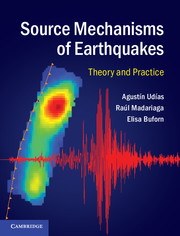Book contents
- Frontmatter
- Contents
- Preface
- Chapter 1 Earthquakes and fault motion
- Chapter 2 Processing and analysis of recorded seismic signals
- Chapter 3 Mathematical representation of the source
- Chapter 4 Point source models
- Chapter 5 The seismic moment tensor
- Chapter 6 Determination of point source mechanisms
- Chapter 7 Kinematics of extended sources
- Chapter 8 Determination of source dimensions
- Chapter 9 Simple dynamic models
- Chapter 10 Dynamics of fracture. Homogeneous models
- Chapter 11 Fracture dynamics. Heterogeneous models
- Chapter 12 Modeling earthquakes using fracture dynamics
- References
- Index
Chapter 11 - Fracture dynamics. Heterogeneous models
Published online by Cambridge University Press: 05 June 2014
- Frontmatter
- Contents
- Preface
- Chapter 1 Earthquakes and fault motion
- Chapter 2 Processing and analysis of recorded seismic signals
- Chapter 3 Mathematical representation of the source
- Chapter 4 Point source models
- Chapter 5 The seismic moment tensor
- Chapter 6 Determination of point source mechanisms
- Chapter 7 Kinematics of extended sources
- Chapter 8 Determination of source dimensions
- Chapter 9 Simple dynamic models
- Chapter 10 Dynamics of fracture. Homogeneous models
- Chapter 11 Fracture dynamics. Heterogeneous models
- Chapter 12 Modeling earthquakes using fracture dynamics
- References
- Index
Summary
In the previous chapter we studied the propagation of rupture in a material that we assumed to be otherwise unbroken, continuous and perfectly elastic outside the fracture. A direct consequence of these assumptions is that the stress and slip rate present inverse square root singularities as we approach the tip of the crack. These two singularities result from approximations that need to be corrected, since no material of finite strength can sustain infinite stresses or slip at an infinite rate. Moreover, homogeneous models cannot explain the nucleation and arrest of rupture nor the super-shear rupture speeds that sometime occur in earthquake ruptures. To avoid these problems we need to introduce heterogeneities into the medium. These will explain the beginning of the fracture process and its arrest and will also eliminate the singularities of stress and slip rate at the rupture edge.
The cohesive zone
We start with a study of the singularities at the edge of a propagating fracture. In order that the values of the stress and slip rate near the rupture front be finite it is necessary to introduce a transition zone where the material behaves inelastically. Barenblatt (1959a, b, 1962) proposed that the stresses immediately ahead of the fracture front should be regularized by the action of cohesive forces, which hold together the material while it is in the process of being broken. These forces are distributed in the vicinity of the rupture front and may be considered as a material property. They are analogous to the attractive or cohesive forces exerted on a liquid molecule by neighboring molecules which explains their name. The transition zone where these forces act is called the cohesive zone and its dimension d must be small compared with the size of the fracture (Fig. 11.1). At the front of the cohesive zone the opposite sides at the edge of the crack are smoothly joined and the stresses remain finite. Let us consider a very simple model of a cohesive zone of length d where the cohesive stresses are constant and equal to σc, which is a compressive stress that opposes the opening of the cohesive zone. Generally, the cohesive stress σc is larger than the acting stress σ0 (Fig. 11.1). Behind the cohesive zone, at distance d from the tip, the tensional stresses drop to zero.
- Type
- Chapter
- Information
- Source Mechanisms of EarthquakesTheory and Practice, pp. 232 - 258Publisher: Cambridge University PressPrint publication year: 2014



